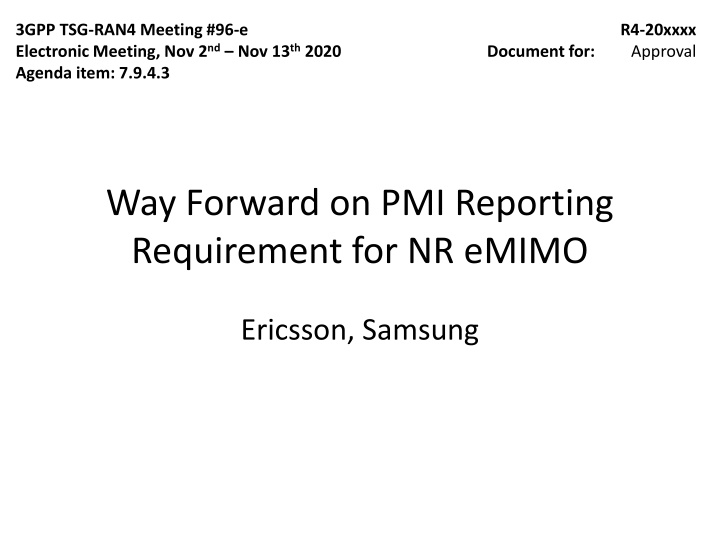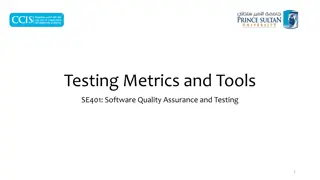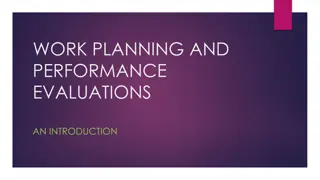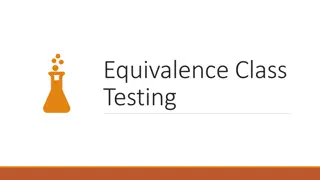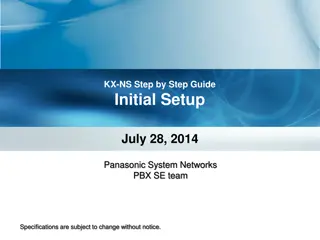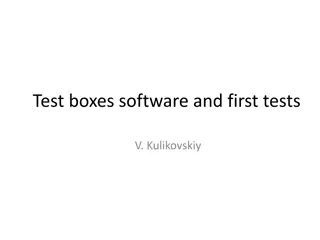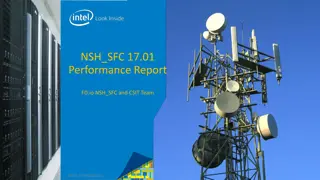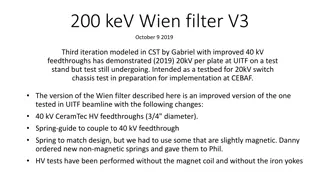Enhanced Type II Testing Setup for NR eMIMO Performance Evaluation
This document outlines the test setup and parameters for conducting enhanced Type II testing to evaluate the performance of NR eMIMO systems. It includes details on the test metrics, test procedures, and performance requirements for different codebooks and scenarios. The testing setup covers aspects such as CSI-RS ports, PMI sub-bands, codebook configurations, channel models, and beam-steering models. The simulation assumptions focus on aligning beam-steering approaches and generating random PMI for comparison between eType II and Type I codebooks.
Download Presentation

Please find below an Image/Link to download the presentation.
The content on the website is provided AS IS for your information and personal use only. It may not be sold, licensed, or shared on other websites without obtaining consent from the author.If you encounter any issues during the download, it is possible that the publisher has removed the file from their server.
You are allowed to download the files provided on this website for personal or commercial use, subject to the condition that they are used lawfully. All files are the property of their respective owners.
The content on the website is provided AS IS for your information and personal use only. It may not be sold, licensed, or shared on other websites without obtaining consent from the author.
E N D
Presentation Transcript
3GPP TSG-RAN4 Meeting #96-e Electronic Meeting, Nov 2nd Nov 13th2020 Agenda item: 7.9.4.3 R4-20xxxx Approval Document for: Way Forward on PMI Reporting Requirement for NR eMIMO Ericsson, Samsung
Enhanced Type II Test Setup Introduce Rel-16 eType II codebook requirements with SU-MIMO set-up under the condition that with proper test parameters, test metric/test requirements and test procedure to ensure enough performance difference over than Type I i.e. UE which employ Type I reporting will fail in the test case Test metric : Further check results based on following candidate options during 2ndround Option 1: Following PMI/Random PMI Option 2: Following with eType II codebook / following PMI with Type I codebook Further study and define proper performance requirements if needed under MU-MIMO scenario in Rel-17 performance enhancement WI. The same agreements applied for Rel-15 Type II test case(s).
Test Parameters for SU-MIMO Test Setup - I Number of CSI-RS ports: 16 ports with (N1,N2) = (4,2) and (O1,O2)=(4,4) Number of PMI Sub-bands per CQI Sub-band R = 1 Codebook parameter configuration paramCombination-r16: 6, with L =4, p =1/2, =1/2 Sub-band Size: 4 for FDD with 15kHz SCS, 10MHz CBW 8 for TDD with 30kHz SCS, 40MHz CBW
Test Parameters for SU-MIMO Test Setup - II Channel Model TDLA30-5 MIMO Correlation XP Medium as Baseline XP (custom) Low only can be considered if XP medium not workable MCS and Rank MCS 20 (64QAM Table), Rank 2
Test Parameters for SU-MIMO Test Setup - III Beam-Steering Model How to specify beam steering model into specification. Same as specified in B.2.3B.4A of TS 36.101
Simulation Assumption alignment Beam-Steering Approach Enable two independent beam directions applying the beam for comparison both eType II and Type I cookbook simulation
Simulation Assumption alignment Random PMI generation for W2 with eType II codebook Select the main beam index (i18,l) from 2L beams randomly, l is the layer index Fix the main beam with following amplitude (Table 5.2.2.2.5-2, Table 5.2.2.2.5-3 in spec) and phase coefficient indicators. Amplitude=1, Phase =0 Select the remaining NZ coefficients from the table of amplitude and phase coefficient indicators over the (Beam x FD basis) grid until reaching K0 per layer Note: The number of chosen coefficients per layer should be chosen randomly (number of ones in i17 bitmap); Loop by the layer, and repeat the step1-3. Stop if 2K0 is reached across all layers Precoder is constructed according to Table 5.2.2.2.5-5
Test metric for using random PMI reference Take the test metric with TP ratio of following eType II PMI/random eType II PMI as test metric for Rel-16 Type II codebook if there is performance difference with the following feasibility checking with TP ratio 1a and TP ratio 1b metric as TP ratio 1a: following eType II PMI/random eType II PMI TP ratio 1b: following Type I PMI/random eType II PMI Test point Option 1: 70% Option 2: 90% (baseline) Check whether the test metric with following eType II PMI/following Type I is feasible for optional UE features. with only supporting eType II codebook?
Simulation results summary (FDD 16x2 XP Medium) Rel-15 Type I PMI Rel-16 eType II PMI TP ratio eType II/Type I (90%) TP ratio of following eType II PMI/random eType II PMI TP ratio of following eType II PMI/random eType II PMI Company SNR in dB at 90% of TP SNR in dB at 90% of TP Samsung 6.3 10.33 15.0 2.0 2.1 Qualcomm 8.45 5.76 13.84 2.1 2.75 Ericsson 11.3 2.03 14.2 1.75 1.23 Huawei Apple 11.4 3.05 14.5 2.1 1.11
Simulation results summary (FDD 16x4 XP Medium) Rel-15 Type I PMI Rel-16 eType II PMI TP ratio eType II/Type I (90%) TP ratio of following eType II PMI/random eType II PMI TP ratio of following eType II PMI/random eType II PMI Company SNR in dB at 90% of TP SNR in dB at 90% of TP Samsung [1.81] [11.5] [8.47] [2.15] [1.94] Qualcomm Ericsson 5.24 2.6 8.65 1.9 1.43 Huawei Apple
Simulation results summary (TDD 16x2 XP Medium) Rel-15 Type I PMI Rel-16 eType II PMI TP ratio eType II/Type I (90%) TP ratio of following eType II PMI/random eType II PMI TP ratio of following eType II PMI/random eType II PMI Company SNR in dB at 90% of TP SNR in dB at 90% of TP Samsung [5.76] [62.81] [13.08] [2.49] [1.95] Qualcomm Ericsson 7.97 2.91 10.41 2.09 1.19 Huawei Apple
Simulation results summary (TDD 16x4 XP Medium) Rel-15 Type I PMI Rel-16 eType II PMI TP ratio eType II/Type I (90%) TP ratio of following eType II PMI/random eType II PMI TP ratio of following eType II PMI/random eType II PMI Company SNR in dB at 90% of TP SNR in dB at 90% of TP Samsung [3.17] [291.74] [9.06] [3.84] [1.82] Qualcomm Ericsson 3.47 2.58 4.59 2.26 1.13 Huawei Apple
Simulation Assumptions for SU-MIMO Test Setup For initial simulations: Use the parameters listed in previous slides. The remaining parameters will be same as for Rel- 15 Type II codebook simulation assumptions in R4- 20xxxxx. Interested companies are encouraged to provide the simulation results in the next meeting, including both eType II and Type I under the same simulation assumption
For information: (Custom) Low correlation:
